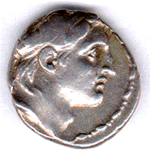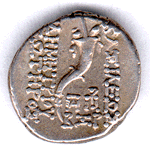COINS OF
INDO-GREEK DYNASTIES
After death of Alexander in 323 BC, his generals, known as diadochi
started fighting for his massive empire. Seleukos Nictator, a friend and
general of Alexander proclaimed himself King of Persia,Bactria (afghanistan)
and Syria. He founded a dynasty named after him, widely known as Seleukid
dynasty. He had his capital at Babylon and invaded India (modern Punjab,
located in northern India and Pakistan) in 304 BC, which was then Muaryan
empire ruled by Chandragupta Maurya. Chandragupta
Maurya (Sandrocottus according to Greek Historians) put an army of
hundred thousand men and 9000 war elephants on battle field! The sheer
number of men on battlefield and the battle elephants (I guess Greeks
were more worried of beasts rather than Indian soldiers) made Seluekos change
his mind. Wisely, Seleucus concluded an alliance and gave his daughter in
marriage to Chandragupta. He also transferred Kabul, Kandahar (modern
Afganistan) and Baluchistan (modern Pakistan) to Chandragupta. Chandragupta
in turn presented him with 500 war elephants. Seleukos sent an ambassador
named Magasthenes to Chandragupta's court, who repeatedly visited Patliputra
(modern patana in Bihar state), capital of Chandragupta. Magasthenes has
written detailed description of India and Chandragupta's reign, which is
perhaps the earliest description of ancient India by a foreign traveller.
Seleukos minted Coins bearing his name which are rare gold staters and
silver tetradrachms/drachms (some day I shall introduce the image).
In 281 BC Seleukos was assasinated but the kings who followed him
maintained friendly relationship with mighty Mauryan emperors for some time
(records exist that Antiochus II was in friendly terms with Chandragupta's son
Bindusara). Seleucid empire disintegrated soon after assasination of
Seleukos into Parthia (Arsaces as King), Syria (Antiochus I as king) and
Bactria (Diodotus as king). During 151-150 BC, a Seleukid pretender, Alexander
Balas, Attalos II of Pergamum, Ariarathes V of Cappadocia, Ptolemy VI and
the Roman Senate, arrived in Ake-Ptolemais, to lay claim to the Seleukid
throne. Within months they won a decisive military victory over Demetrios I,
who was killed in battle. With the defeat of Demetrios I, Phoenicia and
Southern Syria, disputed territory that separated the Seleukids and Ptolemies
was now in the hand of an Egyptian ally. To cement the
alliance between the two empires, Ptolemy VI offered his
daughter in marriage, Cleopatra Thea, to Alexander Balas.
Shown below is the coin minted by Demetrios I, Seleukid Kings of Syria.


Demetrios I, the Soter
162-150 BC
Seleukid King of Syria
Silver drachm
Weight: 4.2 gm
Obverse: Diademed head
Reverse: Cornucopia
Minted at Antioch, Yr 162 BC
Reference: Newell 134
Diodotos was a Seleucid governor of Bactria
who seized the opportunity and declared himself king of Bactria (256 BC). He
soon issued gold and copper coins bearing his portrait on obverse and Greek
deities (prominently Zeus) on reverse. He is considered to be the first
ruler of Indo-Greek dynasties which ruled north-western part of India,
called
Bactria
. He was followed by many kings of Greek origin who ruled this region
for little more than 100 years till arrival of next conquorers, Kushans.

Diodotos
250-230 BC
Indo-Greek Dynasty
Bronze Unit
Weight: 1.00 gm
MAC#1607
After death of last great Mauryan King, Ashoka, India was disintegrated
into many small kingdoms, which provided great opportunity for Indo-Greek
kings for eastern expansion of their kingdoms. Seleucid monarch, Antiochus
III (223-187 BC) carried out the third Greek (first Greek
invasion is considered to be by Alexander while second is by
Seleucus) invasion of India in 206 BC. The first stop was the
Kabul valley in Afghanistan, then ruled by Mauryan governor, Subhagsena
or Subhashsena ( Sophagasenus according to Greek historians).
Interestingly, the invasion did not escalate into a expected massive
bloodshed but resulted into exchange of gifts and Antiochus withdrew from
India. Subhagsena is listed in names of Mauryan princes and also Yadava
dynasty as descendants of Pradyumana. Most Probably, he was a prince of
ancient Vrishni vansha (claims descent from lord Krishna) and also related
to Mauruyan dynasty. Possibly he was a grandson of Ashoka or Ashoka's son
Kunala. Initially, he ruled as governor of Kabul valley from 206 BC but soon
assumed independance on Shunga coup in 185 BC.
After withdrawal of Antiochus from India, Euthydemos consolidated his
realm in Bactria by re-oraganizing the currency and mints. Euthydemos died
in 190 BC and succeded by his son Demetrius. Demetrius (190-171 BC) was the
first Indo-Greek ruler who successfully brought most of the Afganistan,
Punjab and Sindh under his control. He defeated Subhagsena, now king
of Kabul and proudely took a title `King of Indians'. The descendants
of Subhagsena did not die out but went on to found state of zabul (or
Gujni in Afghansistan) before retreating back to Indus/Punjab and are current
Bhatti rulers of Jaisalmer princely state (modern Rajasthan).


Demetrios I
200-190 BC
Indo-greek King of Baktria
Silver drachm
Weight: 4.1 gm
Obverse: Head of Demetrios wearing elephant's skin
Reverse: Herakles holding club and lion's skin
The coins stuck by Euthydemus, Demetrius and Antimachus (weriearing
kausia cap and half mocking smile) are purely Greek in style, in
language and in weight. These coins are THE BEST example of art as applied
to portraiture, anywhwere in the world. Such beautiful coins depicting
lifelike portraits of these kings have no parallel in history. After so
called `conquest of India', Demetrius minted coins showing himself wearing
elephant's scalp which represent the excellent example of portrait coins of
Indo-Greeks. Demetrius was followed by two of his generals,
Apollodotus I and Menander who proclaimed themselves to be kings of this
house. Both ruled in different regions of North Western India.
MENANADER (160-145 BC)
Menander
160-145 BC
Silver drachm, Bilingual
Obverse: Bust of King, Greek legends
Reverse: Pallas, Kharosthi legends
Minted at Panjshir
Weight: 2.33 gm
MAC#1791
Menander is the only Yavana (person of Greek origin in Indian
language) king who has become celebrated in ancient Indian literature. He
is known as `Milinda' who had his capital at Sakala (modern Sialkot in
Pakistan, Euthymedia in Greek). He one of the two leading characters of a
Pali (ancient language of India) treatise Milindpanha (Questions of
Milinda). This book describes fundamental principles of Buddhist
philosophy which is narrated in form of a dialogue between King Milinda
and Buddhist scholar Nagasena. Thus Menander is well known for Indian
historians as a philosopher with superior knowledge in various schools of
thought and not as a mighty conqueror. He was born at Charikar, a country
between Kabul and Panjshir rivers, a connecting link between Bactria and
India. Menander has earned tremendous fame as a great ruler not only in
India but also in Greek world. There is no doubt that he was great
conqueror and ruled over large area. His coins are found in all of modern
Afganistan, Pakistan and north western region of modern India.
The numismatic record of Menander is extraordinarily good which shows
greater variety and wider distribution than those of any other Indo-Greek
ruler. Shown above is a fine example of his coin minted at Taxila
(Takshshila). This is a bilingual coin with interrupted legends. On obverse
is king throwing Javelin, the legends are in Greek, King Soter Menander
while reverse shows Pallas Athene facing left with sloping shield. The
legends on reverse are in ancient Indian language Prakrit, written in
Kharoshthi script which reads
Maharajasa tratasa Menandrasa (-of the king, saviour, Menander) .
APOLLODOTUS I (180-160 BC)
Apollodotus I
180-160 BC
Silver drachm
Obverse: Elephant, Greek legends
Reverse: Humped bull, Kharosthi legends
minted at Taxila
Weight: 2.38 gm
Reference: MIG#207h, MAC#1754
Another general of Demetrius who became king and minted beautiful
coins. Shown above is very atteactive coin mintd by him which is square
in shape. Before arrival of Indo-Greeks, local population of his newly
acquired kingdom had been using
rectangular/square shaped punch-marked coins for most transactions. Perhaps
this fact had enfluenced him to issue square shaped, bilingual coinage which
can be accepted readily by local merchants. Secondly, to keep up with
Indian tradition of punching animals like Elephant and Bull on punch-marked
coin, this coin also bear these two animals on the coin. The legends on
reverse are in Prakrit, written in Kharoshthi script which reads
Maharajasa tratarasa Apaladatasa(-of the king, saviour, Apollodotus
).
PHILOXENUS (110-80 BC)
Philoxenus
110-80 BC
Silver tetradrachm
Minted at Pushkalavati
Weight: 7.32 gm
MAC#1959
Bactrian king Antimachus claimed that he was a successor of Diodotus and
thus belonged to house of Euthydemus. He ruled in lower Kabul Valley
consisting of Jalalabad and Peshwar districts (part of modern Afganistan
and Pakistan). He was succeded by Philoxenus and Diomedes who jointly
ruled the western Indo-Greek kingdom from river Indus to Qunduz region of
bactria.Their coins depicts king wearing flat cap (kausia)
sitting on prancing horse. Philoxenus kingdom consited of Valley of Jhelum
river. His coins are found only to the east of Jalalabad district.
Philoxenus and Diomedes were succeded by two pairs of kings: Archebios,
Peucolaus and Theophiles Nicias. Archebios and Peucolaus issued coins in
Kabul valley and Koht in 80-60 BC while Theophiles and Nicias struck their
coins in Gandhara. Shown above is fine example of coin minted by
Philoxenus. On obverse is king throwing Javelin with his name below the
portrait while on reverse is king mounted on prancing horse.
This is another bilingual coin with Greek legends on obverse while
Kharoshti legends Maharajasa apadihatasa Philasinasa on reverse.
NICIAS (80-60 BC)
Niciuas
80-60 BC
Silver tetradrachm
Weight: 9.09 gm
Most likely Nicias was junior colleague of Theophilos
who might have succeded to the kingdom of Gandhara. Coins of Nicias are
found mostly in Jhelum valley (modern Pakistan). Shown above is a
nice example of his coin which is bilingual. On obverse the legends are in
Greek with his name at the bottom of portrait while reverse shows Pallas
facing left with sloping shield. The legends on reverse are in Kharaoshti
which reads `Maharajasa tratarasa Nikiasa'.
HERMAEUS (40-1 BC)
The kings of house of Eucratides ruled in the region south of Hidu Kush
and upper Kabul valley (southern half of modern Afganistan). Hermaeus
belonged to this house and minted coins depicting Zeus enthroned.
Hermaeus was the last Indo-Greek king. His kingdom was invaded
successively by Shakas (Scythias), Pahalavas (parthians) and lastly by
Kushanas. It is very likely that Indo-Greeks were followed by Pahalavas
which in turn were replaced by Kushanas. Coins bearing last Yavana King
Hermaeus and first Kushana ruler Kujula Kadphises are available indicating
eventual passing of Kabul valley and whole of North east India to Kushana
dynasty, the next suzerain power in ancient India.
Shown below are two of his coins portraying him on obverse. On reverse
one can see Zeus enthroned. Both are bilingual coins with Greek legends on
obverse while Kharoshti legends Maharajasa tratarasa Heramayasa on
reverse.
Hermaeus
40-1 BC
Silver tetradrachm
Minted at Chach
Weight: 9.17 gm
MAC#2016
Hermaeus
40-1 BC
Silver tetradrachm
Minted at Kapisa
Weight: 12.72 gm
MAC#2034
The portraits on all Indo-greeks coins are very realistic which express
powerful features and minute personal details very clearly. This indicate
that all the engravers were from same school of art and obviously very well
familiar with Hellinstic art. Indian coinage is greatly enfluenced by
coinage of Indo-Greeks. The policy of rulers to show their subject their true
appearance was totally unknown in Indian subcontinent. The first
Indian King who issued coins bearing his portrait was Saubhuti (Sophytes
or Sopeithes according to Greek historians). He ruled in Bactria or Panjab
in 315-305 BC and minted Greek styled coins (I am hoping to get his coin
which are just too expensive). His silver coins were greatly enfluenced by
his contemporary Bactrian Greek ruler Seleucus Nictator. He is the first
Indian ruler whose name and portrait appears on a coin. The reverse shows
cock standing right.
This section is currently under construction. I am putting together more
images of coins and lot more interesting information. Come back soon!
If you have any comments, please send at
Visitor since 11th Feb 99